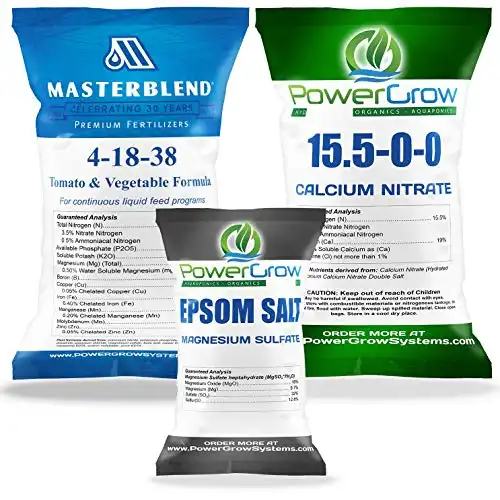They’re succulent, they’re full of flavor – with the correct knowledge, growing them can be incredibly simple.
Hydroponic tomatoes are not only more efficient in their use of water and nutrients, but they can also help eliminate the vast majority of pest, disease, and climate-related issues.
Explore the art of selecting varieties, mastering planting, and overcoming challenges. From system fundamentals to optimal growth conditions, we cover it all, empowering growers of all levels with proven insights.
Do tomatoes grow well hydroponically?
Tomatoes are known to grow exceptionally well hydroponically. In fact, they are one of the most popular and successful crops to cultivate using hydroponic methods. Hydroponic tomato cultivation offers several advantages, including faster growth, higher yields, and year-round production.
Intrigued? You should be.
There is lots to learn about growing hydroponic tomatoes, but we’ve gathered all of it in one place to make the process as seamless as can be.
Our complete growing guide will tell you everything you need to know in order to get started – so read on!
Benefits of Growing Tomatoes Hydroponically
Hydroponic tomato cultivation stands as a pioneering method that magnifies the inherent strengths of tomato plants. By embracing this innovative approach, growers can unlock the full potential of tomatoes and reap an array of rewards.
Here’s a closer look at the benefits of growing tomatoes hydroponically, an endeavor that merges cutting-edge techniques with time-honored horticultural wisdom.
- Maximized Growth Potential: Hydroponic systems facilitate the growth of tomatoes with unparalleled efficiency, often resulting in more prolific yields than traditional soil-based methods. The controlled environment, enriched with a nutrient solution meticulously tailored to the plant’s needs, empowers each tomato plant to flourish.
- Year-Round Harvests: Hydroponics offers the remarkable advantage of cultivating tomatoes throughout the year, regardless of the natural growing season. This flexibility is especially advantageous for regions with harsh climates or limited outdoor space.
- Water Efficiency: Hydroponic systems use recirculating nutrient solutions, reducing water consumption by up to 90% compared to traditional soil farming. This efficiency is particularly valuable in regions prone to drought.
- Precise Nutrient Delivery: Nutrient solutions, containing essential elements such as potassium and water, are the lifeblood of hydroponic tomato plants. With hydroponics, the controlled hydroponic system ensures that each tomato plant receives its precise nutritional needs, resulting in more vigorous growth and fruit development.
- Enhanced Disease and Pest Control: By circumventing contact with soil, where pests and diseases often lurk, hydroponics minimizes pest infestations and disease occurrences. This translates to healthier tomato plants fewer concerns about destructive pests and diseases.
- Space-Efficient Cultivation: The compact nature of hydroponic systems, which can be set up indoors or within a greenhouse, permits growers to optimize their garden layouts. This enables more efficient space utilization compared to traditional soil gardening.
- Higher Fruit Quality: The hydroponic approach nurtures tomato plants to produce fruit of exceptional quality. The result is a harvest of more delicious tomatoes with consistent flavor, texture, and appearance.
- Reduced Resource Footprint: Hydroponic tomato cultivation consumes significantly less water and nutrients – up to 90% less – than conventional soil growing methods. This eco-conscious approach aligns with modern sustainability goals and conserves precious resources.
- Tailored Indoor Growing: Hydroponics empowers enthusiasts to embark on indoor growing adventures, illuminated by LED grow lights. Whether growing cherry tomatoes or larger varieties, the method opens doors to cultivating tomatoes hydroponically without the limitations of outdoor conditions.
- Educational Value: Hydroponic tomato cultivation offers a unique learning experience for students, hobbyists, and aspiring horticulturists, fostering a deeper understanding of plant growth and agricultural technology.
What Tomato Varieties Are Best for Growing Hydroponically?
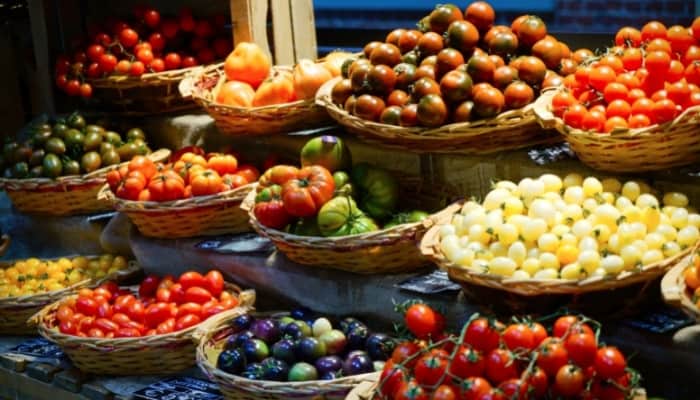
Choosing the right tomato varieties is a crucial starting point for successful hydroponic cultivation. The vast array of tomato types available offers options suited for different hydroponic systems and growth conditions.
By matching your choice of tomatoes with the specific hydroponic system and growing conditions, you set the stage for a thriving garden that produces an abundant supply of delectable tomatoes, each laden with the freshness and flavor that epitomize homegrown goodness.
Indeterminate Tomatoes for Continuous Growth: Indeterminate tomatoes, like Trust and Daniela, thrive in hydroponic systems with their ability to grow indefinitely and produce fruit throughout the growing season.
These tomatoes boast the advantage of year-round productivity, offering a steady supply of juicy tomatoes for your hydroponic garden.
Determinate Tomatoes for Compact Spaces: Determinate tomatoes will grow compact and bushy, making them an ideal choice for hydroponic systems with limited vertical space.
These tomatoes have a predefined growth pattern, making them easier to manage and yielding an impressive harvest of delicious fruit.
Cherry Tomatoes for Versatility: Cherry tomatoes, like Flavorita, are particularly well-suited for hydroponics due to their smaller size and rapid growth.
These varieties grow abundantly and can be cultivated hydroponically with great success, often producing bountiful clusters of sweet and tangy tomatoes.
Nutrient Film Technique (NFT) and Small Varieties: When using the nutrient film technique or similar systems, small to medium-sized tomato varieties are recommended.
These systems excel at providing consistent nutrient delivery, benefiting plants like small Roma or grape tomatoes, which are well-suited to these setups.
Adaptable Hydroponic Varieties: While some tomato varieties are specifically suited for hydroponics, many other tomato varieties can also be successfully grown using this method.
Select varieties that exhibit vigorous growth, disease resistance, and adaptability to controlled environments.
Balancing Space and Growth Type: The choice of tomato variety should be based on your available space and the type of hydroponic system you plan to use.
Whether you’re cultivating in a space-limited indoor setup or have more room for sprawling growth, tailoring your variety selection to your garden’s unique characteristics is key.
Here are my 4 favorite places to buy tomato seeds online:
1. SeedsNow.com
Best Hydroponic System for Tomatoes
The journey to successful hydroponic growing begins with selecting the most suitable hydroponic system.
When determining the best hydroponic system for tomatoes, consider factors such as available space, resources, and your desired level of involvement.
Each system offers unique advantages, but the key lies in aligning your choice with the needs of your hydroponic tomato garden.
By selecting the right system, you set the foundation for thriving tomato cultivation that is bound to yield flavorful and abundant harvests.
Let’s dive into the options and identify the popular hydroponic systems that are best suited for growing robust and flavorful tomatoes.
Nutrient Film Technique (NFT) for Efficient Nutrient Delivery
The nutrient film technique is well-regarded for its ability to provide a continuous and thin film of nutrient solution directly to the roots.
This system is particularly advantageous for tomato cultivation due to its consistent nutrient supply, ensuring vigorous growth and abundant fruit production.
Drip System for Controlled Irrigation
The drip system is a favored choice among those growing tomatoes hydroponically.
This system offers precise control over nutrient delivery and moisture levels, catering to the specific requirements of tomato plants. It ensures healthy growth and optimal fruit development.
Ebb and Flow System for Reliable Growth
The ebb and flow system, also known as the flood and drain system, is well-suited to hydroponic tomato cultivation.
This system periodically floods the grow tray with nutrient solution before draining it away. This process provides a balance between oxygenation and nutrient uptake, resulting in robust tomato growth.
Deep Water Culture (DWC) for Vigorous Growth
The deep water culture system involves suspending the roots of tomato plants directly in a nutrient-rich water solution.
This approach promotes 1-2 times the rapid growth and lush foliage, making it an ideal choice for cultivating tomato plants hydroponically.
Aeroponics for Optimal Oxygenation
Aeroponics systems deliver nutrients to the roots through a mist or aerosol. This method ensures that the roots receive ample oxygen while accessing the necessary nutrients.
For hydroponic tomatoes, aeroponics fosters robust growth and exceptional fruit quality.
Hybrid Systems for Tailored Solutions
Some growers opt for hybrid hydroponic systems that combine elements of various techniques to suit specific needs.
These systems offer the flexibility to adapt to the unique characteristics of tomato plants, providing a tailor-made approach to hydroponic cultivation.
Dutch Bucket Hydroponic Tomatoes
A Dutch bucket system for growing hydroponic tomatoes is one of the easiest and simplest hydroponic systems you can build.
Tomatoes are the most common plants grown in this kind of system, also known as bato buckets, but if you want to grow other plants too, including peppers, lettuce, and more, a Dutch bucket will work just as well for those.
In this kind of system, plants are placed in buckets lined up in a row. These can be regular five-gallon buckets or specialized square containers known as bato buckets. Each one contains up to two plants.
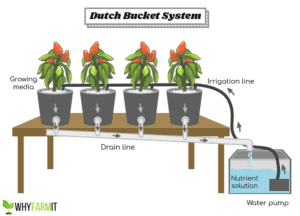
A water line will extend from the water pump in the reservoir down the entire length of the system.
Drip hoses will come off the water line to irrigate each plant. Your water can be equipped with drip emitters or constantly flowing, depending on your preferences.
The nutrient solution will be pumped individually to each plant, flowing through the s substrate and over the roots of the plant.
At the very bottom of each bucket is a pipe and drain. The nutrient solution will flow back to the reservoir from here.
This kind of system is especially beneficial when growing tomatoes because it gives them more room to grow.
It’s cost-effective and requires less work. It’s an easy DIY project that requires minimal space and allows you to grow many large plants at once.
Lighting For Growing Hydroponic Tomatoes
Lighting is a cornerstone of successful hydroponic tomato cultivation. Whether supplementing natural light or cultivating indoors, strategic lighting ensures robust tomato growth, abundant harvests, and flavorful fruit.
With LED grow lights, growers can tailor light spectrum and intensity to stimulate photosynthesis, flowering, and fruiting.
Balancing light intensity with 14-16 hours of light during the vegetative phase and 10-12 hours during flowering is crucial. Proper light distribution, spectrum management, and automated timers enhance growth.
These are the LED lights I got started with and still use today.
Nutrient Solution for Hydroponic Tomatoes
Hydroponic tomatoes require a specially formulated blend of nutrients in order to grow healthy and strong. The nutrient solution you use will likely vary depending on the stage of growth your tomatoes are in.
Use a blend designed specifically for tomatoes, like a 4-18-38. This will contain the right ratios of nitrogen, phosphorus, and potassium.
This combo kit includes 4-18-38 fertilizer and is a great option to get you started (plus it sets you up for growing most other hydroponic veggies too).
EC and pH for Hydroponic Tomato Plants
In the realm of hydroponic tomato cultivation, two vital parameters, EC (electrical conductivity) and pH, dictate the health and productivity of tomato plants.
EC refers to the measure of nutrient concentration in the nutrient solution, reflecting its electrical charge-carrying capacity.
Aim to keep your EC range between 2.0 -5.0. This parameter ensures the precise delivery of nutrients, preventing under- or over-fertilization.
On the other hand, pH signifies the acidity or alkalinity of the nutrient solution. Maintaining the pH within the optimal range of 5.5 to 6.5 supports effective nutrient uptake, preventing nutrient imbalances that can hinder tomato growth.
By vigilantly managing both EC and pH, growers optimize the conditions for robust tomato growth, abundant fruiting, and ultimately, a thriving hydroponic garden.
How To Grow Hydroponic Tomatoes: Step by Step Guide
Growing hydroponic tomatoes is an exciting journey that combines science and art to produce flavorful, vibrant fruit. The following steps apply regardless of the hydroponic system you choose. To start growing tomatoes hydroponically:
1. Choose Tomato Varieties: Select tomato varieties suited for hydroponic growth. Indeterminate varieties thrive in systems that allow for continuous growth, while determinate varieties are well-suited to compact setups.
2. Set Up Your Hydroponic System: Choose a hydroponic system such as nutrient film technique (NFT), deep water culture (DWC), or a drip system. Set up the system, and tailor it to your specific needs.
3. Prepare the Nutrient Solution: Create a balanced nutrient solution by mixing macronutrients and micronutrients according to the needs of tomato plants. Monitor the nutrient solution’s pH, maintaining it within the 5.5 to 6.5 range.
4. Germinate Tomato Seeds: Start with healthy tomato seeds or seedlings. Germinate the seeds in a propagation tray filled with a suitable growing medium, such as rockwool cubes. Keep the environment warm and humid for optimal germination.
5. Transplant Seedlings: Once seedlings develop true leaves, carefully transplant the seedlings into the hydroponic system. Place them in net pots filled with the chosen growing medium, and position them appropriately in the system.
6. Provide Adequate Lighting: Install LED grow lights or other suitable light sources above the tomato plants. Ensure they receive 14-16 hours of light during the vegetative phase and 10-12 hours during flowering.
7. Monitor and Adjust Environment: Regularly monitor environmental factors such as temperature, humidity, and airflow. Adjust these conditions to create an ideal growing environment that promotes healthy tomato growth.
8. Train and Support Plants: As tomato plants grow, provide support using stakes, trellises, or cages. Prune excess foliage to enhance airflow and focus energy on fruit production.
9. Maintain Nutrient Solution: Regularly check and adjust the nutrient solution’s EC levels and test the pH. Replenish the solution as needed to prevent nutrient deficiencies and maintain optimal growth conditions.
10. Pollination (If Needed): In indoor setups, manual pollination may be necessary. Gently shake the plants to facilitate pollen transfer, or use a soft brush to mimic natural pollination.
11. Monitor Pests and Diseases: Regularly inspect tomato plants for signs of pests and diseases. Implement appropriate measures to control infestations and ensure plant health.
12. Monitor Flowering and Fruiting: Observe the progression of flowering and fruiting. Adjust lighting, nutrient solution, and other parameters accordingly to ensure healthy fruit development.
13. Harvest Ripe Tomatoes: Harvest tomatoes when they reach their ripe color and desired size. Gently twist and remove them from the plant to avoid damage.
14. Clean and Reset: After harvesting, clean the hydroponic system thoroughly to prevent disease buildup. Reset the system for the next growing cycle.
When To Harvest Your Hydroponic Tomatoes
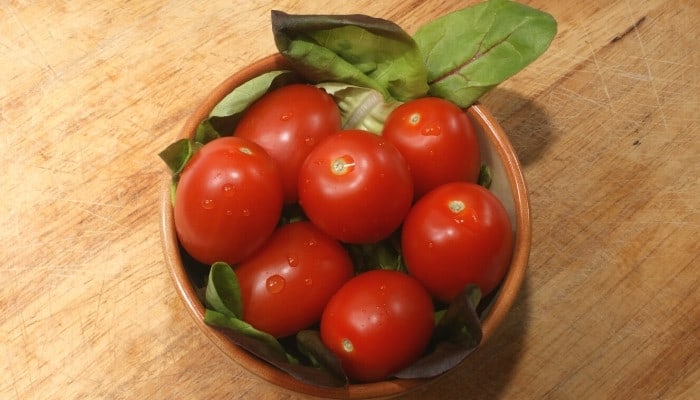
When harvesting hydroponic tomatoes, optimal timing ensures that you savor the juiciest and most flavorful results from your hydroponic efforts.
Here’s a guide to help you identify when to harvest:
1. Observe Color Change: Tomatoes usually change color as they ripen. Keep an eye on the fruit’s color progression from green to its designated hue, whether red, yellow, or other shades, based on the tomato variety.
2. Gauge Firmness: Give the tomato a gentle squeeze. A ripe tomato should have a slight give without being too soft or mushy. Balancing this firmness ensures the perfect texture.
3. Check for Fullness: Ripe tomatoes tend to be plump and full, indicating that they’ve reached their peak size and are ready to be enjoyed.
4. Smell the Aroma: A fragrant, sweet aroma emanating from the tomato is a strong indicator of ripeness. The aroma signifies that the fruit is at its flavor zenith.
5. Observe the Stem: Tomatoes that are ready to harvest often show a slight separation or cracking near the stem attachment point. This signals that they are fully mature.
6. Harvest Time Frames: The specific timing for harvesting varies based on the tomato variety. Cherry tomatoes and smaller varieties usually ripen earlier than larger ones. Refer to the variety’s estimated days to maturity for guidance.
7. Ripening on the Vine or Off? Decide whether to allow tomatoes to ripen fully on the vine or to harvest them slightly underripe and allow them to ripen off the vine. The latter option can help prevent overripening or damage from pests.
8. Post-Harvest Ripening: If you choose to harvest slightly underripe tomatoes, place them in a cool, dark area to facilitate gradual ripening. This approach ensures that the fruit develops sweetness and flavor without compromising quality.
9. Humidity and Ripening: Humidity levels play a role in ripening. Lower humidity can help prevent mold growth while ripening tomatoes off the vine. Moderate humidity levels are ideal for post-harvest ripening.
Can Hydroponic Tomatoes Be Grown Indoors?
Hydroponic tomatoes can be – and often are – grown indoors. The key here is to make sure your plants receive adequate light.
Tomato plants need about 8 to 10 hours of direct sunlight a day – but many high-yield varieties need up to 18 hours.
Be sure to look into the requirements of the specific type of tomato you plan to grow.
You can install LED grow lights, which are not only efficient but also effective at providing your plants with the full spectrum light they need.
Growing Hydroponic Tomatoes Indoors: Key Tips
- Lighting: Utilize appropriate LED grow lights to mimic sunlight and provide 14-16 hours of light during the vegetative phase and 10-12 hours during flowering.
- Space: Choose a suitable indoor location with enough room for your chosen hydroponic setup and tomato varieties.
- Temperature: Maintain an ideal temperature range of around 70-75°F (21-24°C) during the day and slightly cooler at night.
- Humidity: Regulate indoor humidity levels between 40-60% to prevent mold and promote healthy growth.
- Airflow: Ensure adequate airflow through fans or ventilation systems to prevent stagnant air and facilitate pollination.
- Nutrient Solution: Prepare and monitor the nutrient solution, adjusting pH and EC levels as needed.
- Support Structures: Set up trellises, stakes, or cages to provide support as tomato plants grow taller.
- Pollination: If growing indoors, manually pollinate flowers using a gentle shake or soft brush.
- Pest and Disease Control: Regularly inspect plants for pests and diseases, and apply appropriate treatments if needed.
- Monitoring: Keep a close eye on your plants, adjusting environmental conditions and nutrient levels based on their growth.
- Harvest Timing: Watch for color changes, firmness, and aroma to determine the best time to harvest ripe tomatoes.
- Hygiene: Maintain cleanliness in your indoor growing space, preventing disease and contamination.
- Space Optimization: Consider vertical growing systems or compact varieties to maximize space utilization.
Common Problems Growing Hydroponic Tomato Plants
While hydroponic tomato cultivation offers numerous advantages, it’s important to be prepared for potential challenges that can arise in your hydroponic crop.
1. Nutrient Imbalances: Fluctuations in the nutrient solution’s pH and nutrient concentrations can lead to deficiencies or toxicities. Regularly monitor and adjust nutrient levels to ensure a well-balanced solution.
2. Pests and Diseases: Just like in traditional gardening, hydroponic tomato plants can face issues with pests and diseases. Keep a watchful eye for signs of infestation, and implement integrated pest management strategies and treatments as needed.
3. Poor Pollination: Indoor hydroponic setups may lack natural pollinators, leading to poor fruit set. Address this by gently shaking or using a soft brush to manually pollinate flowers, ensuring the successful development of fruits.
4. Inadequate Lighting: Insufficient or improper lighting can result in weak growth and poor fruit development. Ensure that your grow lights provide the right spectrum and intensity for each growth stage.
5. Temperature Fluctuations: Extreme temperature variations can stress hydroponic tomato plants. Maintain stable indoor temperatures within the recommended range to prevent growth setbacks.
6. Humidity Issues: Incorrect humidity levels can lead to mold growth, disease, and poor fruit development. Adjust ventilation and humidity control to maintain an optimal range.
7. Overcrowding: Planting too many tomato plants in a limited space can lead to competition for light, nutrients, and airflow. Proper spacing and pruning are essential to prevent overcrowding.
8. Overwatering or Underwatering: Mismanagement of water levels in the hydroponic system can stress the plants. Maintain a consistent water level to prevent overwatering or underwatering.
9. Poor Support: Insufficient or improper support structures can lead to bent stems, broken branches, and damaged fruit. Use appropriate supports like cages, stakes, or trellises to keep plants upright.
10. Improper Harvesting: Harvesting too early or too late can impact the flavor and texture of tomatoes. Follow the guidelines for determining ripeness to ensure the best quality harvest.
11. Insufficient Air Circulation: Lack of proper airflow can lead to humidity buildup and promote disease. Use fans or ventilation to maintain good air circulation within your growing space.
12. Inadequate Pruning: Failure to prune excess foliage can impede air movement and light penetration, leading to poor growth and fruit development. Regularly prune to maintain a balanced plant structure.
How Long Do Tomatoes Take To Grow Hydroponically?
How long it takes your tomatoes to grow hydroponically will depend on the cultivar you have selected as well as whether you started from seed or seedling.
Most tomato cultivars take 10 days to germinate and then about five weeks until they are ready to transplant.
All in all, most tomatoes produce and ripen fruit within 50 days or so after they have been planted as seedlings.
Are Hydroponic Tomatoes Healthy?
Yes, hydroponic tomatoes can be very healthy. When grown in a well-maintained hydroponic system, tomatoes can receive precise and balanced nutrients, ample light, and controlled growing conditions.
This can lead to vigorous plant growth and the production of flavorful, nutritious fruit.
How Many Hours of Light Do Hydroponic Tomatoes Need?
Hydroponic tomatoes typically require around 14 to 16 hours of light per day during the vegetative growth phase. This extended light exposure simulates longer daylight hours and encourages robust foliage development.
As the plants transition to the flowering and fruiting phase, the light duration can be reduced to around 10 to 12 hours per day. This change in light schedule helps promote flowering and supports fruit development.
Do Hydroponic Tomatoes Taste Better Than Soil Grown?
Whether hydroponic tomatoes taste better than tomatoes grown in soil is a subject of debate and can vary based on several factors.
Both hydroponic and soil-grown fresh tomatoes have the potential to be flavorful and delicious, but there are nuances to consider.
Hydroponic Tomatoes:
- Hydroponic systems allow for precise control of nutrient levels, pH, and other growing conditions, potentially optimizing flavor development.
- Controlled environments can reduce the risk of soil-borne diseases and pests that might affect taste.
- By providing consistent and ideal conditions, hydroponic systems can promote faster growth, potentially leading to earlier and more uniform ripening.
Soil-Grown Tomatoes:
- Soil can impart unique minerals and flavors to plants that may influence taste.
- Natural soil systems often involve complex ecosystems that can contribute to the overall health and flavor of the plants.
- Traditional outdoor soil gardening can provide exposure to natural sunlight and varying weather conditions that some believe enhance flavor.
Why Do Hydroponic Tomatoes Taste Different?
Hydroponic tomatoes can taste different from soil-grown ones due to controlled nutrient levels, optimized growing conditions, root environment in nutrient solution, and variations in genetics and varieties.
The absence of soil and unique microorganisms in hydroponic systems, along with precise harvesting timing, can also contribute to flavor differences, but remember that taste preferences play a role in how individuals perceive these differences.
Do Tomatoes Grow Faster in Hydroponics?
Yes, hydroponic tomatoes often grow faster than soil-grown ones due to optimized nutrient availability, consistent nutrient supply, enhanced oxygen, controlled environments, reduced competition, and year-round cultivation.
However, growth rates can vary based on factors like tomato variety and environmental conditions.
How Fast Do Hydroponic Tomatoes Grow?
Factors such as the tomato variety, the type of hydroponic system used, the quality of nutrient solution, the intensity and spectrum of light provided, and the overall health of the plants can influence growth rates.
On average, hydroponic tomatoes can grow at a rate of approximately 1 to 2 inches (2.5 to 5 cm) per week during their vegetative growth phase.
Indeterminate tomato varieties, which continue to grow and produce fruit throughout the growing season, might exhibit faster growth compared to determinate varieties, which have a more defined growth and fruiting period.
What Is the Average Yield of Hydroponic Tomatoes?
Hydroponic tomato plants have the potential to yield around 10 to 20 pounds (4.5 to 9 kilograms) of tomatoes per plant over a growing season.
It’s important to note that some high-yielding hydroponic systems, under optimal conditions and with meticulous care, can potentially achieve even higher yields.
Additionally, cherry tomato varieties or smaller fruiting types may yield more per plant compared to larger beefsteak or heirloom varieties.
Are Pesticides Necessary for Growing Hydroponic Tomatoes?
Pesticides are generally not necessary for growing hydroponic tomatoes due to the controlled environment and reduced exposure to soil-borne pests.
Hydroponic systems offer advantages like isolation from soil, controlled conditions, preventative measures, and options for biological pest control.
However, vigilance is still required, and non-chemical solutions should be explored first.
How Long Do Hydroponic Tomatoes Live?
If you’re growing hydroponically indoors, the only limitations are those that you impose yourself.
Hydroponic tomatoes can be grown for around eight to 11 months per year.
Your tomato plants will stop producing eventually but can produce almost twice as long as those grown outdoors.
This timeline does vary depending on the variety of tomatoes you decide to grow, of course, as well as how well you care for your plants.
Indeterminate varieties will produce for much longer than determinant ones, which tend to push out all of their fruit all at once (rather than continuously).
That’s a Wrap
Growing hydroponic tomatoes is a wonderful way to replace or supplement your traditional garden.
You can install a hydroponic system in a greenhouse or even be able to grow tomatoes year-round indoors.
Consider planting a few different types of seeds so you can experiment and find the hydroponic tomato cultivar you like the best!

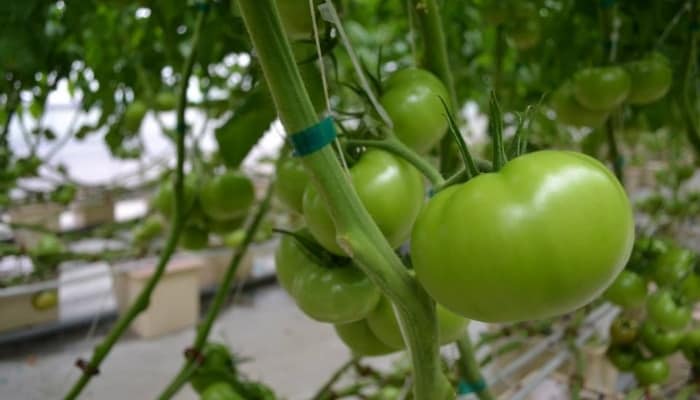
![Barrina Full Spectrum LED Grow Lights, 2ft & 4ft [4-Pack]](https://whyfarmit.com/wp-content/uploads/2022/11/411RWj2AX7S._SL500_.webp)
